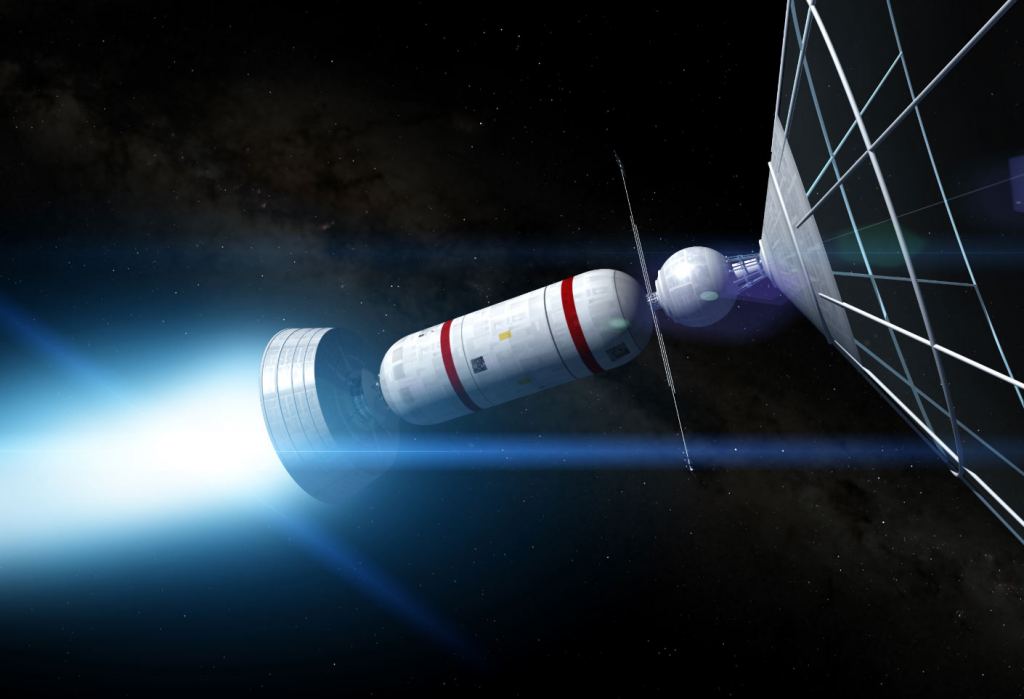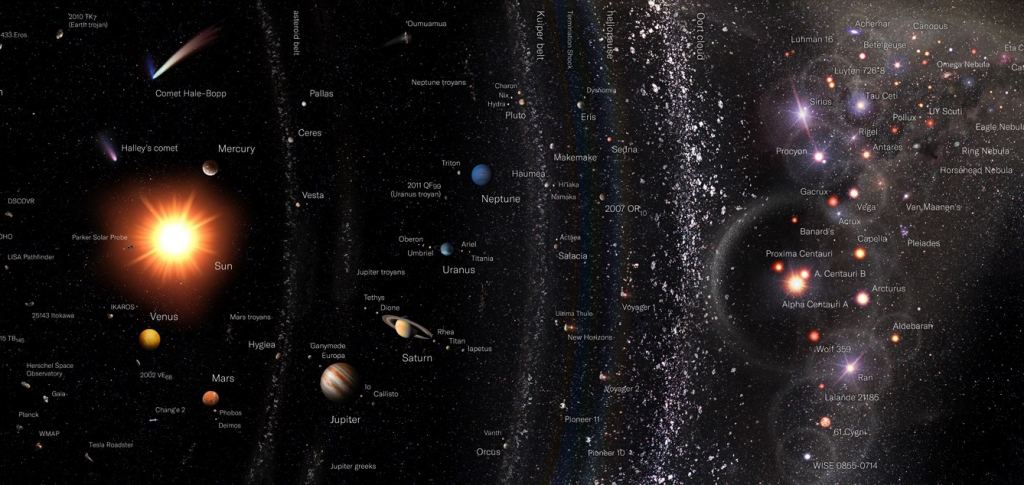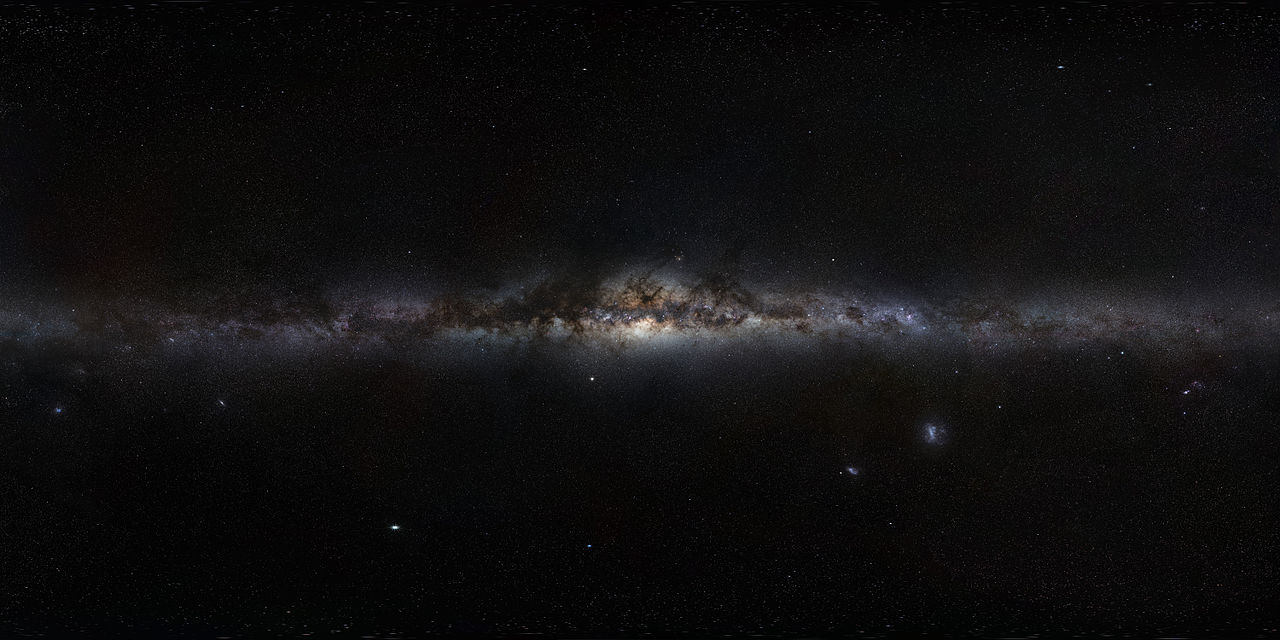Welcome back to our Fermi Paradox series, where we take a look at possible resolutions to Enrico Fermi’s famous question, “Where Is Everybody?” Today, we examine the possibility that Earth hasn’t been visited by aliens because interstellar travel is not very practical!
In 1950, Italian-American physicist Enrico Fermi sat down to lunch with some of his colleagues at the Los Alamos National Laboratory, where he had worked five years prior as part of the Manhattan Project. According to various accounts, the conversation turned to aliens and the recent spate of UFOs. Into this, Fermi issued a statement that would go down in the annals of history: “Where is everybody?“
This became the basis of the Fermi Paradox, which refers to the disparity between high probability estimates for the existence of extraterrestrial intelligence (ETI) and the apparent lack of evidence. Since Fermi’s time, there have been several proposed resolutions to his question, which includes the very real possibility that interstellar colonization follows the basic rule of Percolation Theory.
One of the key assumptions behind the Fermi Paradox is that given the abundance of planets and the age of the Universe, an advanced exo-civilization should have colonized a significant portion of our galaxy by now. This is certainly not without merit, considering that within the Milky Way galaxy alone (which is over 13.5 billion years old), there are an estimated 100 to 400 billion stars.
Another key assumption is that intelligent species will be motivated to colonize other star systems as part of some natural drive to explore and extend the reach of their civilization. Last, but certainly not least, it assumes that interstellar space travel would be feasible and even practical for an advanced exo-civilization.
But this, in turn, comes down to the assumption that technological advances will provide solutions to the single-greatest challenge of interstellar travel. In short, the amount of energy it would take for a spacecraft to travel from one star to another is prohibitively large, especially where large, crewed spacecraft would be concerned.
Relativity is a Harsh Mistress
In 1905, Einstein published his seminal paper in which he advanced his Special Theory of Relativity. This was Einstein’s attempt to reconcile Newton’s Laws of Motion with Maxwell’s Equations of electromagnetism in order to explain the behavior of light. This theory essentially states that the speed of light (in addition to being constant) is an absolute limit beyond which objects cannot travel.
This is summarized by the famous equation, E=mc2, which is otherwise known as the “mass-energy equivalence.” Put simply, this formula describes the energy (E) of a particle in its rest frame as the product of mass (m) with the speed of light squared (c2) – approx. 300000 km/s; 186000 mi/s. A consequence of this is that as an object approaches the speed of light, its mass invariably increases.
Therefore, for an object to reach the speed of light, an infinite amount of energy would have to be expended accelerating it. Once c was achieved, the mass of the object would also become infinite. In short, achieving the speed of light is impossible, never mind exceeding it. So barring some tremendous revolution in our understanding of physics, a Faster-Than-Light (FTL) propulsion system can never exist.
Such is the consequence of living in a relativistic Universe, where traveling at even a fraction of the speed of light requires tremendous amounts of energy. And while some very interesting and innovative ideas have been produced over the years by physicists and engineers who want to see interstellar travel become a reality, none of the crewed concepts are what you might call “cost-effective.”
A Matter of Principle
This raises a very important philosophical question that is related to the Fermi Paradox and the existence of ETIs. This is none other than the Copernican Principle, named in honor of famed astronomer Nicolaus Copernicus. To break it down, this principle is an extension of Copernicus’ argument about the Earth, how it was not in a unique and privileged position to view the Universe.
Extended to the cosmological realm, the principle basically asserts that when considering the possibility of intelligent life, one should not assume that Earth (or humanity) is unique. Similarly, this principle holds that the Universe as we see it today is representative of the norm – aka. that it is in a state of equilibrium.
The opposing view, that humanity is in a unique and privileged position to observe the Universe, is what is known as the Anthropic Principle. In a nutshell, this principle states that the very act of observing the Universe for signs of life and intelligence requires that the laws that govern it be conducive to life and intelligence.
If we accept the Copernican Principle as a guiding principle, we are forced to concede that any intelligent species would face the same challenges with interstellar flight as we do. And since we do not foresee a way around these, barring major a breakthrough in our understanding of physics, perhaps no other species has found one either. Could this be the reason for the “Great Silence”?
Origin
The notion that distance and time may be a factor (in relation to the Fermi Paradox) has received quite a bit of consideration over time. Carl Sagan and William I. Newman suggested in their 1981 study, “Galactic civilizations: Population dynamics and interstellar diffusion,” that signals and probes by ETIs may simply not have reached Earth yet. This was met with criticism by other scientists who argued that it contradicted the Copernican Principle.
By Sagan and Newman’s own estimates, the time it would take for an ETI to have explored the entire galaxy is equal to or less than the age of our galaxy itself (13.5 billion years). If an exo-civilization’s probes or signals have not reached us yet, this would imply that sentient life started to emerge in the more recent past. In other words, the galaxy is in a state of disequilibrium, moving from a state of being uninhabited to inhabited.
However, it was Geoffrey A. Landis who made what is perhaps the most compelling argument about the limits imposed by the laws of physics. In his 1993 paper, “The Fermi paradox: an approach based on percolation theory,” he argued that as a consequence of Relativity, an exo-civilization would only be able to expand so far throughout the galaxy.
Central to Landis’ argument was the mathematical and physics statistics concept known as “percolation theory,” which describes how a network behaves when nodes or links are removed. In accordance with this theory, when enough of the network’s links are removed, it will break down into smaller connected clusters. According to Landis, this same process is useful in describing what happens to people engaged in migration.
In short, Landis proposed that in a galaxy where intelligent life is statistically likely, there will not be a “uniformity of motive” among extraterrestrial civilizations. Instead, his mode assumes a wide variety of motives, with some choosing to venture out and colonize while others choose to “stay at home.” As he explained it:
“Since it is possible, given a large enough number of extraterrestrial civilizations, one or more would have certainly undertaken to do so, possibly for motives unknowable to us. Colonization will take an extremely longtime, and will be very expensive.
“It is quite reasonable to suppose that not all civilizations will be interested in making such a large expenditure for a pay off far in the future. Human society consists of a mixture of cultures which explore and colonize, some times over extremely large distances, and cultures which have no interest in doing so.”
To summarize, an advanced species would not colonize the galaxy rapidly or consistently. Instead, it would “percolate” outwards to a finite distance, where increasing costs and the lag time between communications imposed limits and colonies evolved their own cultures. Thus, colonization wouldn’t be uniform but would happen in clusters with large areas remaining uncolonized at any given time.
A similar argument was made in 2019 by Prof. Adam Frank and a team of exoplanet researchers from NASA’s Nexus for Exoplanetary Systems Science (NExSS). In a study titled “The Fermi Paradox and the Aurora Effect: Exo-civilization Settlement, Expansion, and Steady States,” they argued that settlement of the galaxy would also occur in clusters because not all potentially-habitable planets would be hospitable for a colonizing species.
Of course, Landis’ model contains some inherent assumptions of its own, which he laid out beforehand. First, there was the assumption that interstellar travel is difficult due to the laws of physics and that there is a maximum distance over which colonies can be directly established. Hence, a civilization will only colonize within a reasonable distance from its home, beyond which secondary colonization will occur later.
Second, Landis also makes the assumption that the parent civilization will have a weak grasp over any colonies it creates, and the time needed for these to develop their own colonization capability will be very long. Hence, any colony established will develop its own culture over time and its people will have a sense of self and identity distinct from that of the parent civilization.

As we explored in a previous article, it would take between 1000 and 81,000 years to reach Proxima Centauri (4.24 light-years away) using current technology. While there are concepts that would allow for relativistic travel (a fraction of the speed of light), the travel time would still be anywhere from a few decades to over a century. What’s more, the cost would be extremely prohibitive (more on that below).
But getting colonists to another star system is just the beginning. Once they have settled a nearby habitable planet (and not all died off) and have the infrastructure for interstellar communications, it would still take 8 and a half years to send a message to Earth and receive an answer. That’s simply not practical for any civilization hoping to maintain centralized control or cultural hegemony over its colonies.
Space is Expensive!
To put things in perspective, consider the costs associated with humanity’s own history of space exploration. Sending astronauts to the Moon as part of the Apollo Program between 1961 and 1973 cost a hefty $25.4 billion, which works out to about $150 billion USD today (when adjusted for inflation). But Apollo did not occur in a vacuum, and first required Project Mercury and Project Gemini as stepping stones.
These two programs, which put the first American astronauts in orbit and developed the necessary expertise for getting to the Moon, respectively ran about $2.3 billion and $10 billion USD (when adjusted). Add them all up, and you get a grand total of around $163 billion spent from 1958 to 1972. By comparison, Project Artemis, which will return astronauts to the Moon for the first time since 1972, will cost $35 billion over just the next four years!

That doesn’t include the costs of getting all the various components to this stage in the game, like the development of the SLS thus far, the Orion space capsule, and research into the Lunar Gateway, human landing systems (HLS), and robotic missions. That’s a lot of money just to get to Earth’s only satellite. But that’s nothing compared to the costs of interstellar missions!
Going Interstellar?
Since the dawn of the Space Age, many theoretical proposals have been made for sending spacecraft to the nearest stars. At the heart of each and every one these proposals was the same concern: can we reach the nearest stars in our lifetimes? In order to meet this challenge, scientists contemplated a number of advanced propulsion strategies that would be capable of pushing spacecraft to relativistic speeds.
Of these, the most straightforward was definitely Project Orion (1958 to1963), which would rely on a method known as Nuclear Pulse Propulsion (NPP). Led by Ted Taylor of General Atomics and physicist Freeman Dyson from the Institute for Advanced Study at Princeton University, this project envisioned a massive starship that would use the explosive force generated by nuclear warheads to generate thrust.
These warheads would be released behind the spacecraft and detonated, creating nuclear pulses. These would be absorbed by a rear-mounted pressure plate (aka. “pusher”) that translate the explosive force into forward momentum. Though inelegant, the system was brutally simple and effective, and could theoretically achieve speeds of up to 5% the speed of light (5.4×107 km/hr, or 0.05 c).

Alas, the cost. According to estimates produced by Dyson in 1968, an Orion spacecraft would weight between 400,000 and 4,000,000 metric tons. Dyson’s most conservative estimates also placed the cost of building such a craft at $367 billion ($2.75 trillion when adjusted for inflation). That’s about 78% of the US government’s annual revenue for 2019, and 10% of the country’s GDP.
Another idea was to build rockets that rely on thermonuclear reactions to generate thrust. Specifically, the concept of Fusion Propulsion was investigated by the British Interplanetary Society between 1973 and 1978 as part of a feasibility study known as Project Daedalus. The resulting design called for a two-stage spacecraft that would generate thrust by fusing pellets of a deuterium/helium-3 in a reaction chamber using electron lasers.
This would create a high-energy plasma that would then be converted to thrust by a magnetic nozzle. The first stage of the spacecraft would operate for just over 2 years and accelerate the spacecraft to 7.1% the speed of light (0.071 c). This stage would then be jettisoned and the second stage would take over and accelerate the spacecraft up to about 12% of light speed (0.12 c) over the course of 1.8 years.
The second-stage engine would then be shut down and the ship would enter into a 46-year cruise period. According to the Project’s estimates, the mission would take 50 years to reach Barnard’s Star (less than 6 light-years away). Adjusted for Proxima Centauri, the same craft could make the trip in 36 years. But in addition to technological barriers identified by the Project, there was also the sheer costs involved.

Even by the modest standard of an uncrewed concept, a fully-fueled Daedalus would weight as much as 60,000 Mt and cost over $5,267 billion (based on 2012 estimates). Adjust to 2020 USD, the price tag for a fully-assembled Daedalus would cost close to $6 trillion. Icarus Interstellar, an international organization of volunteer citizen scientists (founded in 2009) have since attempted to revitalize the concept with Project Icarus.
Another bold and daring idea is Antimatter Propulsion, which would rely on the annihilation of matter and antimatter (hydrogen and antihydrogen particles). This reaction unleashed as much energy as a thermonuclear detonation, as well as a shower of subatomic particles (pions and muons). These particles, which would then travel at one-third the speed of light, are channeled by a magnetic nozzle to generate thrust.
Unfortunately, the cost of producing even a single gram of antimatter fuel is estimated to be around one trillion dollars. According to a report by Robert Frisbee of NASA’s Advanced Propulsion Technology Group (NASA Eagleworks), a two-stage antimatter rocket would need over 815,000 metric tons (900,000 US tons) of fuel to make the journey to Proxima Centauri in approximately 40 years.
A more optimistic report by Dr. Darrel Smith & Jonathan Webby of the Embry-Riddle Aeronautical University states that a spacecraft weighing 400 metric tons (441 US tons) and 170 metric tons (187 US tons) of antimatter fuel could reach 0.5 the speed of light. At this rate, the craft could reach Proxima Centauri in a little over 8 years, but there’s no cost-effective way to do this and no guarantees there ever will be.

In all cases, propellant makes up a large fraction of these concept’s overall mass. To address this, variations have been proposed that could generate their own propellant. In the case of fusion rockets, there’s the Bussard Ramjet, which uses an enormous electromagnetic funnel to “scoop” hydrogen from the interstellar medium and magnetic fields to compress it to the point that fusion occurs.
Similarly, there’s the Vacuum to Antimatter Rocket Interstellar Explorer System (VARIES), which also creates its own fuel out of the interstellar medium. Proposed by Richard Obousy of Icarus Interstellar, a VARIES ship would rely on large lasers (powered by enormous solar arrays) that would create particles of antimatter when fired at empty space.
Alas, neither of these ideas are possible using current technology, nor are they within the realm of cost-effectiveness (not by a long shot). Under the circumstances, and barring several major technological developments that would reduce the associated costs, it would be fair to say that any idea for interstellar crewed missions is simply impractical.
Sending probes to other stars within our lifetimes is still within the realm of possibility, especially those that rely on Directed-Energy Propulsion (DEP). As proposals like Breakthrough Starshot or Project Dragonfly show, these sails could be accelerated to relativistic speeds and have all the necessary hardware to gather pictures and basic data on any orbiting exoplanets.

However, such probes are a potentially-reliable and cost-effective means of interstellar exploration, not colonization. What’s more, the time-lag involved in interstellar communications would still place constraints on how far these probes could explore while still reporting back to Earth. Therefore, an exo-civilization is not likely to send probes very far beyond the boundaries of its territory.
Criticisms
A possible criticism of percolation theory is that it allows for many scenarios and interpretations that would permit contact to have happened at this point. If we assume that an intelligent species would similarly take 4.5 billion years to emerge (the time between Earth’s formation and modern humans), and consider that our galaxy has been around for 13.5 billion years, that still leaves a 9 billion years window.
For 9 billion years, multiple civilizations could have come and gone and while no one species could have colonized the entire galaxy, it’s hard to imagine that this activity would have gone unnoticed. Under the circumstances, one may be forced to conclude that in addition to their being limits to how a civilization can reach that there are other limiting factors at work here (Great Filter, anyone?)
However, it is important to remind ourselves that no proposed resolution to the Fermi Paradox is without its share of holes. Also, expecting a theory or theorist to have all the answers to a subject as complex (yet data-poor) as the existence of extraterrestrials is about as unrealistic as expecting consistency in the behavior of ETIs themselves!

Overall, this hypothesis is highly useful because of the way it breaks down many of the assumptions inherent to “Fact A.” It also presents an entirely logical starting point for answering the fundamental question. Why haven’t we heard from any ETIs? Because it’s unrealistic to conclude that they should have colonized the better part of the galaxy by now, especially when the laws of physics (as we know them) preclude such a thing.
We have written many interesting articles about the Fermi Paradox, the Drake Equation, and the Search for Extraterrestrial Intelligence (SETI) here at Universe Today.
Want to calculate the number of extraterrestrial species in our galaxy? Head on over to the Alien Civilization Calculator!
Here’s Where Are The Aliens? How The ‘Great Filter’ Could Affect Tech Advances In Space, Why Finding Alien Life Would Be Bad. The Great Filter, How Could We Find Aliens? The Search for Extraterrestrial Intelligence (SETI), and Fraser and John Michael Godier Debate the Fermi Paradox.
And be sure to check out the rest of our Beyond Fermi’s Paradox series:
- Beyond “Fermi’s Paradox” I: A Lunchtime Conversation- Enrico Fermi and Extraterrestrial Intelligence
- Beyond “Fermi’s Paradox” II: Questioning the Hart-Tipler Conjecture
- Beyond “Fermi’s Paradox” III: What is the Great Filter?
- Beyond “Fermi’s Paradox” IV: What is the Rare Earth Hypothesis?
- Beyond “Fermi’s Paradox” V: What is the Aestivation Hypothesis?
- Beyond “Fermi’s Paradox” VI: What is the Berserker Hypothesis?
- Beyond “Fermi’s Paradox” VII: What is the Planetarium Hypothesis?
- Beyond “Fermi’s Paradox” VIII: What is the Zoo Hypothesis?
- Beyond “Fermi’s Paradox” IX: What is the Brief Window Hypothesis?
- Beyond “Fermi’s Paradox” X: What is the Firstborn Hypothesis?
- Beyond “Fermi’s Paradox” XI: What is the Transcension Hypothesis?
- Beyond “Fermi’s Paradox” XII: What is the Water Worlds Hypothesis?
- Beyond “Fermi’s Paradox” XIII: What is the “Ocean Worlds” Hypothesis?
- Beyond “Fermi’s Paradox” XIV: What is the Aurora Hypothesis?
- Beyond “Fermi’s Paradox” XI: What is the Transcension Hypothesis?
- Beyond “Fermi’s Paradox” XII: What is the Water World Hypothesis?
- Beyond “Fermi’s Paradox” XIII: What is the “Ocean Worlds” Hypothesis?
- Beyond “Fermi’s Paradox” XIV: What is the Aurora Hypothesis?
- Beyond “Fermi’s Paradox” XVI: What is the “Dark Forest” Hypothesis?
- Beyond “Fermi’s Paradox” XVII: What is the “SETI-Paradox” Hypothesis?
Astronomy Cast has some interesting episodes on the subject. Here’s Episode 24: The Fermi Paradox: Where Are All the Aliens?, Episode 110: The Search for Extraterrestrial Intelligence, Episode 168: Enrico Fermi, Episode 273: Solutions to the Fermi Paradox.
Sources:
- Sagan, C. & Newman, N.I. “Galactic Civilizations: Population Dynamics and Interstellar Diffusion.” Icarus, Volume 46, Issue 3 (1981)
- Sagan, C. & Newman, N.I. “The Solipsist Approach to Extraterrestrial Intelligence.” Quarterly Journal of the Royal Astronomical Society, Vol. 24 (1983)
- Brin, G.D. “The Great Silence – the Controversy Concerning Extraterrestrial Intelligent Life.” Quarterly Journal of the Royal Astronomical Society, Vol. 24 (1983)
- Jones, E.M. “‘Where Is Everybody?’ An Account of Fermi’s Question.” Office of Scientific & Technical Information Technical Reports (1985)
- Landis, G.A. “The Fermi paradox: an approach based on percolation theory.” Journal of the British Interplanetary Society, Vol. 51, No. 5 (1993)

